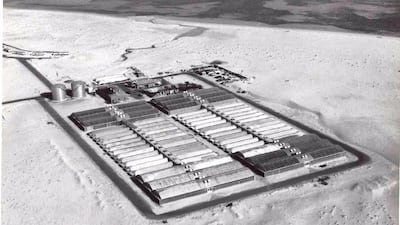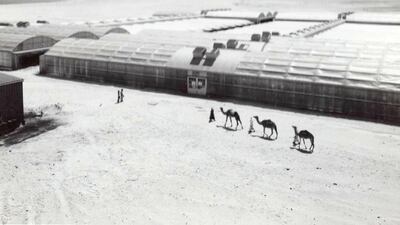Saadiyat Island, 1969. It was a harsh, waterless expanse of white sand, inhabited by a handful of fishermen living in simple palm frond huts. But change was coming.
On one part of the island – close to the city side – sat a cluster of new buildings, where an advanced agricultural system known as hydroponics was delivering remarkable yields of cucumbers, tomatoes and lettuce.
Today this story seems like a dream.
Saadiyat is an island of museums, golf courses and five star-hotels but a network of greenhouses operated there from 1969 to the late '70s. It was known as the Arid Lands Research Centre and central to it all was an American professor, Merle Jensen.
Fifty years on from his first visit, the 80-year-old is back in the UAE to reflect on those days.
In the mid-'60s, he was already an expert in hydroponics – using water and not soil to grow vegetables in harsh climates – and had been hired by the University of Arizona to work on a project in Mexico that sought to grow vegetables in an arid coastal environment.
An aide to the Ruler of Abu Dhabi, Sheikh Zayed, saw an article about the project, told him and this set in motion a chain of events that brought Dr Jensen to the UAE.
The university appointed Dr Jensen as research horticulturist and construction started in 1969. Sheikh Zayed had paid $3 million to establish the site and three young Abu Dhabians even travelled to Arizona for training.
“We had Pakistanis. We had Yemenis. We had Baluchis. We were so desperate to get this built,” he said, recalling how bags of cement were shipped in from Iraq.
Some of the greenhouses were air-inflated and the others made of fibreglass, with a crew of at least 26 working on the 5-acre site by 1970. Diesel engines and a desalination unit provided power and water. The vegetables were grown in plastic tubes in which desalinated water injected with fertiliser passed through, a practice Dr Jensen said is 100 times more efficient than traditional irrigation. Vegetables could be grown in just 24 days.

The project caught the interest of the world's media and was featured in TV shows and magazines such as National Geographic. "We didn't have that word then but this thing went viral. This put Abu Dhabi and Sheikh Zayed on the map for science."
About 350 tonnes of produce were grown a year, with yields of lettuce at least double what could be grown in soil. “This supplemented what was grown in Al Ain but we knew water even then was becoming short,” said Dr Jensen.
The greenhouses were cooled using water evaporation which is more cost effective than air conditioning – similar to the ones you see outside many restaurants today. Even the drainage water was recycled. “That’s what we will have to do in the future and we proved this 50 years ago.”
As Dr Jensen flicks through the photographs of his time here, the white sand of Saadiyat blooms into colour with rows and rows of ripe red tomatoes, plump aubergines and huge lettuces being packed into white boxes. Aerial photographs show the greenhouses surrounded by nothing but sand. Transport was by dhow from a jetty.
Sheikh Zayed visited in 1970 and tasted a cucumber that been planted only weeks before. He visited again later that year, proudly bringing the presidents of Gabon and Somalia.
“There was a concrete walkway and I lined that with vegetables. Sheikh Zayed said 'money I have, technology I don’t and I brought the University of Arizona for that'. He was incredibly happy.”

Another famous visitor was Muhammad Ali who came by in 1974 just months before his victory over George Foreman in the historic Rumble in the Jungle in Zaire. Ali was trying to raise funds for an Islamic college he wanted build. “He was very interested in the project and he would shadowbox with the kids.”
Dr Jensen moved into a house on the island with his wife and two children but left by the mid-1970s as his training mission was finished. But larger plans for Saadiyat even then meant the centre had closed by the late 70s. It is believed the greenhouses were moved to Al Ain but it is unclear if vegetables continued to be grown there.

The issue of food security is more important than ever today. The UAE imports about 85 per cent of its food and water resources are under pressure, but the UAE has appointed a minister for food security.
The Ministry of Climate Change and Environment has recently launched a project to help farmers use hydroponics and recent statistics show 20 per cent of fruit and vegetables consumed in the UAE have been grown here.
Dr Jensen, who went on to help design the land pavilion at Disney World, believes with the right investment, it is feasible to feed the entire UAE from crops grown here. “They know the oil days are limited,” he said. “A lot is going into engineering but not agriculture. Bring the best guys in and go for it.”
Dr Jensen, a guest of the US embassy, leaves on Saturday and is staying at a hotel on Saadiyat not far from the original greenhouses.
“I said to one of the hotel guests today – do you know that I was a farmer on this island? They thought I was crazy,” he said with a chuckle. “It is remarkable to me even now.”













